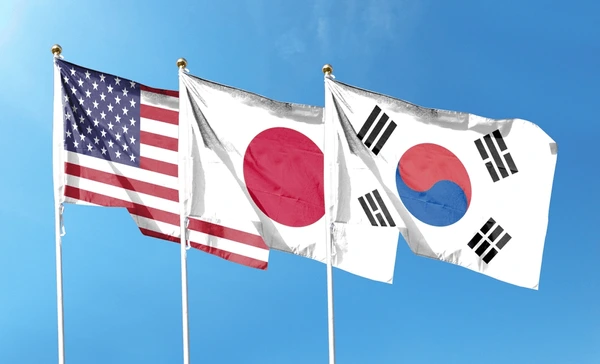A Gathering Storm in Northeast Asia
On September 15, 2025, warships, fighter jets, and cyber units from the United States, Japan, and South Korea will converge in the waters near Jeju Island for the annual Freedom Edge joint military drills. The exercises, which will run through September 19, extend far beyond the usual aerial and naval maneuvers. This year, for the first time, they will include a robust cyber defense component, reflecting the changing nature of conflict in an era when attacks on servers and satellites can be just as devastating as those on ships or cities.
The timing is deliberate. The drills come just weeks after Beijing staged a massive military parade, attended by the leaders of China, Russia, and North Korea, showcasing their own vision of regional power. For Washington, Tokyo, and Seoul, the message of Freedom Edge is clear: alliance cohesion remains strong, and deterrence will not be left to chance.
“The symbolism here is as important as the training itself,” said a South Korean security analyst at a recent forum in Seoul. “It’s about reminding both allies and adversaries that the U.S.-Japan-South Korea partnership is not only intact but evolving with the times.”
The Shadow of North Korea
Freedom Edge is the latest chapter in a decades-long effort to contain the threat from North Korea, whose missile launches and nuclear ambitions have defined the security landscape of Northeast Asia for over thirty years.
Just last month, the U.S. and South Korea staged a ten-day troop mobilization exercise, testing their ability to respond to surprise attacks. Pyongyang responded predictably, denouncing the drills as preparations for invasion. Yet North Korea’s own actions have escalated concerns far more than allied exercises. The regime has test-fired ballistic missiles with increasing frequency, unveiled new intercontinental missile designs, and signaled that its nuclear doctrine is now geared toward first-use in certain scenarios.
“The North wants to project strength, but it is also increasingly reliant on support from Beijing and Moscow,” noted a Japanese defense official. “That dynamic is pushing Seoul, Tokyo, and Washington closer together than ever before.”
A Shifting Regional Landscape
While North Korea remains the immediate concern, China’s rise and its growing alignment with Russia add another layer of urgency. Beijing’s parade this summer was not just military theater but a statement of intent. By hosting Vladimir Putin and Kim Jong Un in its capital, China signaled its willingness to forge a bloc opposed to the U.S.-led order in the Indo-Pacific.
For Tokyo and Seoul, both heavily dependent on secure trade routes and maritime stability, the stakes are high. The South China Sea and the Taiwan Strait loom large in their security calculations, and the possibility of simultaneous crises in the region underscores the need for integrated defense planning.
Freedom Edge, then, is about much more than the Korean Peninsula. It is a demonstration of trilateral unity at a time when adversaries are drawing closer together.
Inside the Drills: Air, Sea, and Cyberspace
The structure of Freedom Edge reflects how wars are fought in 2025: across multiple, overlapping domains.
-
In the air, U.S. F-35s, Japanese F-15s, and South Korean KF-21s will conduct joint interception and surveillance missions.
-
At sea, destroyers and submarines will coordinate anti-submarine operations, testing detection and response capabilities against simulated undersea threats.
-
In cyberspace, military cyber units will simulate defense against attacks on command-and-control systems, an unprecedented addition to Freedom Edge that acknowledges the vulnerability of digital infrastructure.
-
Missile defense drills will involve radar-sharing and interception scenarios, sharpening the three allies’ ability to respond quickly to launches from North Korea or elsewhere.
This integrated approach is not new, but it has been steadily expanding since 2024, when Freedom Edge was first formalized as a trilateral exercise. Each year builds on the last, deepening interoperability and reducing the friction of coordination.
History of an Uneasy Alliance
The U.S.-South Korea military alliance is more than 70 years old, born from the ashes of the Korean War. The U.S.-Japan alliance dates back even further, rooted in the post-World War II security framework. But the trilateral relationship has historically been less straightforward, hampered by longstanding tensions between Seoul and Tokyo over history, trade, and territorial disputes.
For years, these disputes prevented the two countries from fully aligning on defense. Washington often played mediator, encouraging cooperation without always achieving it. That began to shift in 2023, when South Korea and Japan made a breakthrough agreement on historical issues, opening the door to closer military ties. The following year, Freedom Edge was launched, symbolizing the newfound willingness to train together at a high level.
“The fact that Japan and South Korea are not just coordinating bilaterally with the U.S., but with each other, is a breakthrough,” said a former U.S. diplomat. “Freedom Edge would have been unthinkable a decade ago.”
Signaling and Strategy
Beyond tactical readiness, Freedom Edge is designed to send a message. By conducting the drills so soon after Beijing’s parade and amid North Korea’s ongoing provocations, the allies are demonstrating resolve.
South Korea’s Joint Chiefs of Staff have been careful to frame the drills as defensive and consistent with international law, hoping to minimize criticism from Beijing and Moscow. Still, the signal is clear: the U.S., Japan, and South Korea will not allow threats to go unanswered.
For Washington, the exercises also reinforce President Biden’s broader Indo-Pacific strategy, which emphasizes alliances as the backbone of U.S. presence in the region. For Tokyo and Seoul, the stakes are existential, tied directly to their national survival in the event of conflict.
Why Cyber Matters More Than Ever
Perhaps the most striking addition to Freedom Edge 2025 is the emphasis on cyber defense. In recent years, North Korea has been accused of hacking financial institutions, targeting South Korean infrastructure, and even attempting to breach U.S. defense contractors. At the same time, China’s cyber capabilities have grown increasingly sophisticated, posing risks not only to military systems but also to the civilian technologies on which modern societies depend.
By training together in cyber operations, the allies are acknowledging that the next crisis may begin with a digital strike, not a missile launch. This adaptation reflects a broader shift in military planning, where cyber resilience is seen as essential to national defense.
Why Freedom Edge 2025 Matters
-
Preparedness for modern conflict: Integrating cyber defense and missile interception drills ensures readiness against both traditional and hybrid threats.
-
Alliance cohesion: Each iteration of Freedom Edge builds political trust and military interoperability, turning a once-fractured trilateral relationship into a functional defense bloc.
-
Strategic deterrence: Conducting the drills right after adversarial displays of unity reinforces deterrence, showing that the U.S., Japan, and South Korea are aligned in both intent and capability.
-
Regional stability: By emphasizing defensive, law-abiding operations, the allies aim to reassure the region that their purpose is stability, not escalation.
Looking Ahead
The trajectory of Freedom Edge suggests that trilateral cooperation will continue to deepen in the years ahead. Some analysts speculate that the exercises could evolve into a permanent joint command structure, similar to NATO operations in Europe. Others see potential for expanding beyond military drills into coordinated diplomacy, technology sharing, and supply chain security.
Whatever its future form, Freedom Edge reflects a new era of strategic clarity. The three allies are no longer just reacting to North Korea’s provocations– they are preparing together for a broader spectrum of challenges that includes cyber warfare, maritime disputes, and great power competition.
Conclusion
Freedom Edge 2025 is more than a military drill. It is a carefully calibrated show of unity at a time when adversaries are drawing closer together. By bringing together air, sea, and cyber capabilities, the U.S., Japan, and South Korea are demonstrating that they can adapt to the changing face of warfare while preserving their shared commitment to peace and international law.
As the waters near Jeju Island host warships and the skies fill with aircraft this September, the true audience may not be the soldiers in uniform but the leaders in Beijing, Pyongyang, and Moscow. For them, Freedom Edge is a reminder: the Indo-Pacific’s democracies are ready, united, and watching.

